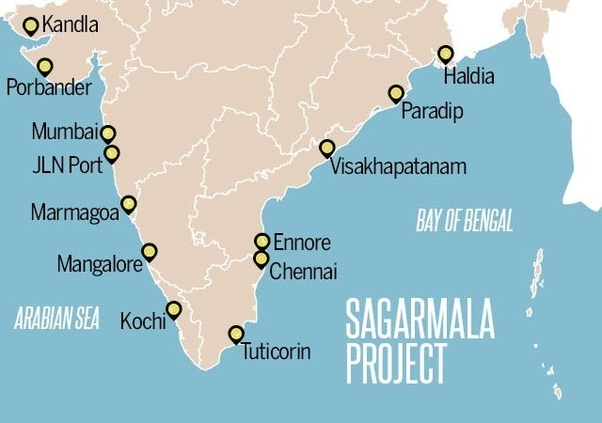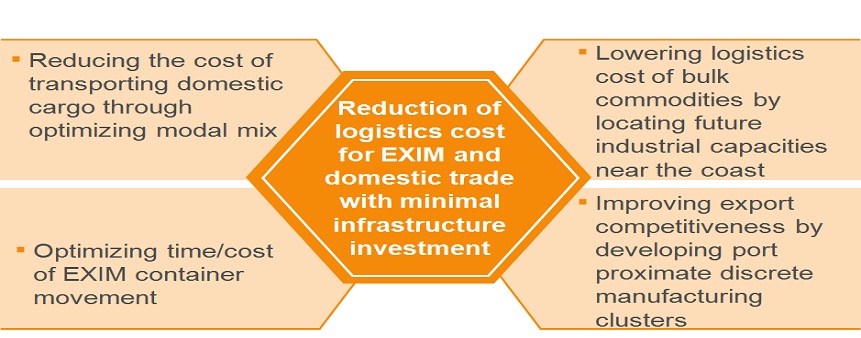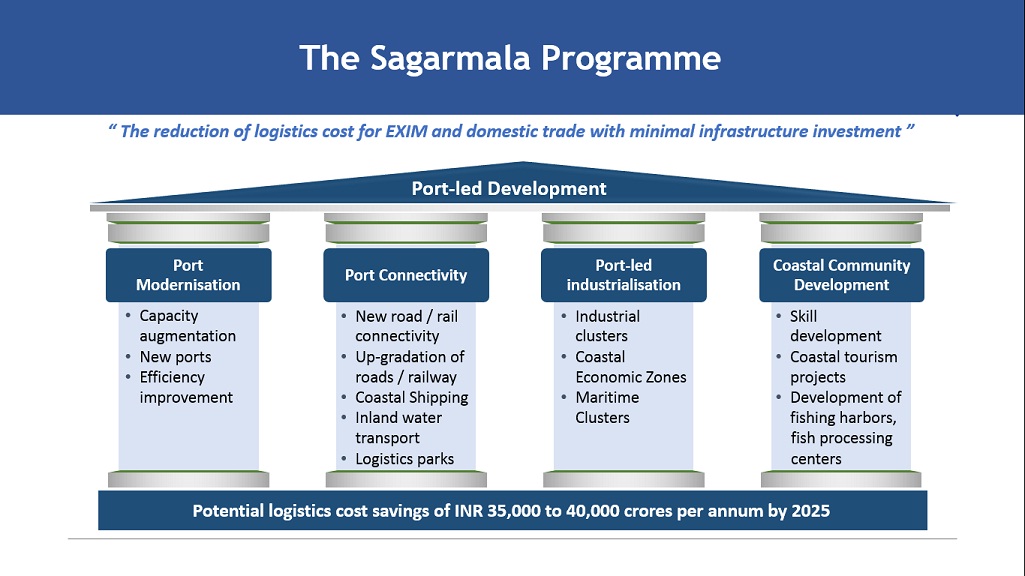





Published on Nov 07, 2018
Sagarmala Programme is large transport and logistics project in India. It entails Rs. 8.5 trillion (US$120 billion or €100 billion) investment for setting up of new mega ports, modernization of India's existing ports, development of 14 Coastal Employment Zones (CEZs) and Coastal Employment Units, enhancement of port connectivity via road, rail, multi-modal logistics parks, pipelines & waterways and promote coastal community development, resulting in boosting merchandise exports by US$110 billion, and generation of around 10,000,000 direct and indirect jobs.
The Sagarmala Programme is the flagship programme of the Ministry of Shipping to promote port-led development in the country through harnessing India’s 7,500 km long coastline, 14,500 km of potentially navigable waterways and strategic location on key international maritime trade routes. Sagarmala aims to modernize India's Ports so that port-led development can be augmented and coastlines can be developed to contribute in India's growth. It also aims for "transforming the existing Ports into modern world class Ports and integrate the development of the Ports, the Industrial clusters and hinterland and efficient evacuation systems through road, rail, inland and coastal waterways resulting in Ports becoming the drivers of economic activity in coastal areas

Sagarmala is an ambitious national initiative aimed at bringing about a step change in India’s logistics sector performance, by unlocking the full potential of India’s coastline and waterways. The vision of Sagarmala is to reduce logistics cost for both domestic and EXIM cargo with optimized infrastructure investment. Sagarmala aspires to reduce logistics costs for EXIM and domestic cargo leading to overall cost savings of INR 35,000 to 40,000 cr. per annum. Some of this will be direct cost savings, while others are savings from inventory-handling costs resulting from time (and reduced variability) in transportation of goods, particularly containers. These cost savings apply to current industrial capacities as well as future coast proximate capacities for energy, material, marine and discrete industries that could come up through port-linked industrialization. In addition, Sagarmala aspires to reduce carbon emissions from transportation sector by 12.5 MT/annum.
The concept of "port led development" is central to the Sagarmala vision. Port-led development focuses on logistics intensive industries (where transportation either represents a high proportion of costs, or timely logistics are a critical success factor). These industries can be structurally competitive if developed proximate to coast/waterways. They would be supported by efficient and modern port infrastructure and seamless multi modal connectivity. The population in adjoining areas would be sufficiently skilled to participate in economic opportunities on offer. The synergistic and coordinated development of the above four components, namely logistics intensive industries, efficient ports, seamless connectivity and requisite skill-base - leads to unlocking of economic value.
Vision of the Sagarmala Programme is to reduce logistics cost for EXIM and domestic trade with minimal infrastructure investment. This includes:
• Reducing cost of transporting domestic cargo through optimizing modal mix
• Lowering logistics cost of bulk commodities by locating future industrial capacities near the coast
• Improving export competitiveness by developing port proximate discrete manufacturing clusters
• Optimizing time/cost of EXIM container movement

• Port Modernization & New Port Development: De-bottlenecking and capacity expansion of existing ports and development of new greenfield ports
• Port Connectivity Enhancement: Enhancing the connectivity of the ports to the hinterland, optimizing cost and time of cargo movement through multi-modal logistics solutions including domestic waterways (inland water transport and coastal shipping)
• Port-linked Industrialization: Developing port-proximate industrial clusters and Coastal Economic Zones to reduce logistics cost and time of EXIM and domestic cargo
• Coastal Community Development: Promoting sustainable development of coastal communities through skill development & livelihood generation activities, fisheries development, coastal tourism etc.
Maritime sector in India has been the backbone of the country’s trade and has grown manifold over the years. To harness India’s 7,500 km long coastline, 14,500 km of potentially navigable waterways and strategic location on key international maritime trade routes, the Government of India has embarked on the ambitious Sagarmala Programme which aims to promote port-led development in the country.
The concept of Sagarmala was approved by the Union Cabinet on 25th March 2015. As part of the programme, a National Perspective Plan (NPP) for the comprehensive development of India’s coastline and maritime sector has been prepared which was released by the Hon’ble Prime Minister, on 14th April, 2016 at the Maritime India Summit 2016.
India is one of the fastest growing large economies in the world with a GDP growth rate of 7.5% in 2015-16 and ports play an important role in the overall economic development of the country. Approximately 95 % of India’s merchandise trade (by volume) passes through sea ports. Many ports in India are evolving into specialized centres of economic activities and services and are vital to sustain future economic growth of the country such as JNPT, Mundra Port, Sikka Port, Hazira Port etc.
However, Indian ports still have to address infrastructural and operational challenges before they graduate to the next level. For example, operational efficiency of Indian ports has improved over the years but still lags behind the global average. Turnaround time (TAT) at major ports was approximately 4 days in 2014-15, whereas global average benchmark is 1-2 days. Some of the private sector ports in India like Mundra and Gangavaram, have been able to achieve a turnaround time of around 2 days.
Secondly, last mile connectivity to the ports is one of the major constraints in smooth movement of cargo to/from the hinterland. Around 87% of Indian freight uses either road or rail for transportation of goods. A significant share of this cargo experiences “idle time” during its transit to the ports due to capacity constraints on highways and railway lines connecting ports to production and consumption centers. Although water-borne transport is much safer, cheaper and cleaner, compared to other modes of transportation, it accounts for less than 6% of India’s modal split. By comparison, coastal and inland water transportation contribute to 47% of China’s freight modal mix, while in Japan and US, this share is 34% and 12.4% respectively. Significant savings can be achieved by shifting movement of industrial commodities like coal, iron ore, cement and steel to coastal and inland waterways.
However, more than 90% of coal currently moves via railways. The constraints on connectivity and sub-optimal modal mix results in higher logistics cost thereby affecting the manufacturing sector and export competitiveness.
The third factor is the location of industries / manufacturing centres vis-à-vis the ports. While cost differential between India and China is not significant on a per tonne km basis, China still has a lower container exporting cost, than the cost in India, due to lower lead distances . Presence of major manufacturing and industrial zones in coastal regions in China, which were developed as part of the Port-Led Policy of the government is the main reason for lower lead distances.
Any programme for port-led development needs to consider the above mentioned factors to effectively harness the potential of India’s long coastline.

Connectivity is one of the critical enablers for ports and the end-to-end effectiveness of the logistics system drives competitiveness for the maritime industry as well. With infusion of new technology and capacity building, the cumulative/ total capacity available at ports can match demand but will not be able to handle additional traffic if the evacuation to and from the port is restricted. It is, therefore, important that connectivity of major ports with the hinterland is augmented not only to ensure smooth flow of traffic at the present level but also to meet the requirements of projected increase in traffic.
India's hinterland connectivity is mainly based on surface transport i.e. road and rail, wherein, domestic waterways (coastal shipping and inland waterways) playing a very limited role. Pipelines are predominantly used only for transporting crude oil, refined petroleum products and natural gas.
In India, smooth connectivity to ports is even more important as the cargo generating centers are mainly in the hinterland instead of in the coastal region. The long lead distance increases the logistics cost and time variability within which the cargo can be delivered.
Under Sagarmala Programme, endeavor is to provide enhanced connectivity between the ports and the domestic production/consumption centres. More than 210 connectivity projects at an estimated investment of more than Rs. 2.44 Lac Crore have been identified. Some of the types of connectivity projects considered are listed below:
• Coastal Berths at various major and non-major ports
• National waterways prioritized for development in the first phase
• Heavy haul rail corridor from Talcher to Paradip
• Connectivity to Dedicated freight corridors
• Last mile rail and road connectivity projects
• Major rail connectivity projects
• Freight friendly Expressway projects connecting the major ports
• Development of Multi-Modal Logistics Parks
• POL Pipelines
Despite having an extensive network of inland waterways in the form of rivers, canals, backwaters and creeks freight transportation by waterways is highly under-utilized. Waterways currently contribute around 6% to India's transportation modal mix, which is significantly less than that in developed economies and some of the developing economies as well.
It is estimated that coastal shipping traffic of about 180-200 MMTPA can be achieved from current and planned capacities across coal, cement, iron and steel, food grains, fertilizers, POL by 2025. Additionally about 60-70 MMTPA of cargo is expected to be moved via inland waterways by 2025.
Availability of dedicated infrastructure will go a long way in promoting coastal shipping as a mode of freight transportation. Hence infrastructure at ports and supporting infrastructure using rail/road and waterways to facilitate coastal movement are being created. These include development of dedicated coastal berths, bunkering and storage at ports and creation of supporting hinterland transport infrastructure with last mile connectivity.
Domestic waterways are more cost effective as well as environmentally friendly means of transporting freight. The cost of transporting coal via coastal shipping is one-sixth of the cost of transporting it by railways. In consideration of the above, National Waterways 1, 2, 4 and 5 can be developed to play an important role in transportation.
The optimised modal mix using inland waterways and coastal shipping would not only reduce logistics cost but also cut down emissions, reduce energy and fuel consumption. It is estimated that reduction of 12.5 MT in total CO2 emission (2.5% of current emission through transport sector) and 1 Million KL in liquid fuel consumption (1.5% of current liquid fuel consumption by transport sector) can be achieved via modal mix optimization. Reduction in logistics cost will give impetus to our manufacturing sector and enhance export competitiveness.
Vision of the Sagarmala Programme is to reduce logistics cost and time for the movement of EXIM and domestic cargo. Development of port-proximate industrial capacities near the coast, in future, is a step in this direction. In this regard, the concepts of Coastal Economic Zones (CEZs), Coastal Economic Units (CEUs), Port-Linked Industrial & Maritime Clusters and Smart Industrial Port Cities have been introduced.
CEZs could be spatial economic regions comprising of a group of coastal districts or districts with a strong linkage to the ports in that region. CEZs are also envisaged to tap synergies with the planned industrial corridor projects.
CEUs will be specific industrial estate projects with a demarcated boundary similar to the DMIC nodes. The CEUs will house the industrial clusters / projects proposed within the CEZ.
Each CEZ will consist of multiple CEUs and more than one industrial cluster can be housed within a CEU. Within each industrial cluster there can be several manufacturing units. To accelerate the CEU development process, it is proposed that CEUs be prioritized in locations where land parcels are available in areas close to a deep draught port and with strong potential for manufacturing.
For promoting port-led industrialization, 14 Coastal Economic Zones (CEZs) covering all the Maritime States and Union Territories have been proposed. CEZ perspective plans have been prepared and Detailed Master Plans will be prepared for 4 pilot CEZs (in Gujarat, Maharashtra, Tamil Nadu and Andhra Pradesh) in the first phase of development.
An Inter-Ministerial Committee (IMC) was constituted under the aegis of NITI Aayog for development of CEZs in India. As recommended by IMC, the institutional framework for development of CEZs would be similar to the institutional framework adopted by DMICDC for development of industrial corridors and industrial nodes.
The development of CEZs will be taken up in phases wherein the first phase of development would focus on developing two large CEZs as pilots.